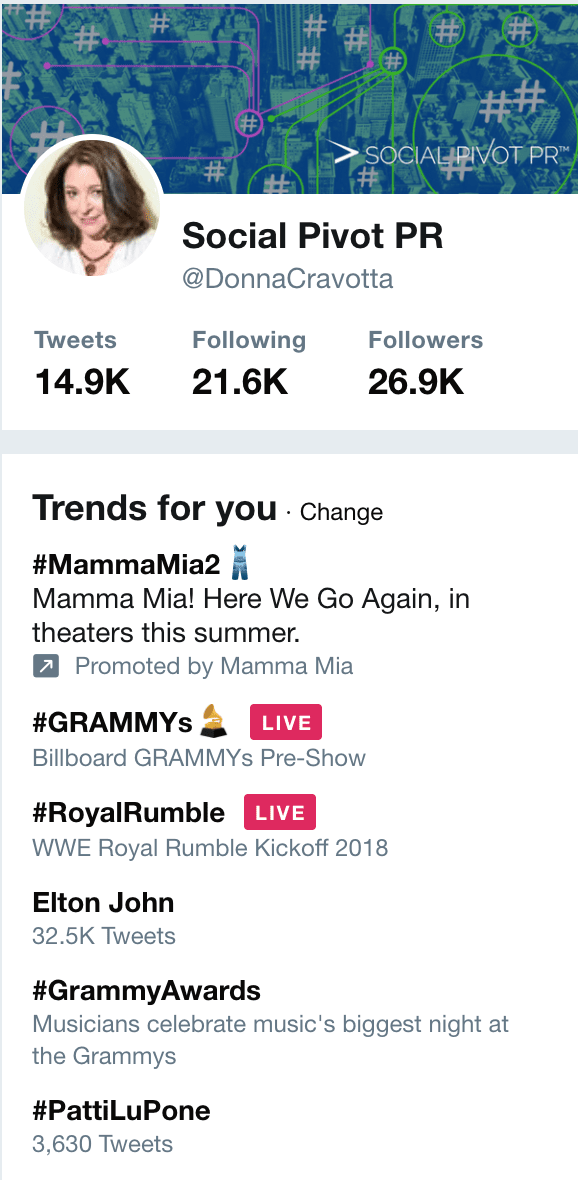One thing I have learned about social media is that often the simplest strategy can be confusing. Such as hashtags, most people do not truly grasp that they are conversations. I love to teach the value of using hashtags and the possibilities that these little nuggets present when an innovative strategy is applied.
Let’s start at the beginning….
What are Hashtags?
Hashtags look like this #hashtag… A word, acronym or collection of characters preceded by (#).
- You can create your own hashtags.
- You can follow other peoples’.
- You can follow company, resource, or location hashtags too (e.g. #Target #SmallBusiness #NYC).
Where to Use Them
Hashtags are used on all social platforms and they are searchable too. A good rule of thumb for how many hashtags to use per platform is:
- Facebook: 1-2 per post, but quite honestly they never took off on Facebook
- Twitter: 1-2 per post and use in your bio
- Instagram: you can use up to 30 hashtags per post, but base the number of hashtags on your desired end result – use a lot of hashtags if you want to be noticed in many conversations/audiences? Alternatively, if your goal is to target small groups of people/companies, use 5-6 specific hashtags to join conversations in a meaningful way.
- LinkedIn: Be very specific about using hashtags here – hashtags are a powerful search tool on LinkedIn.
Benefits of Using Hashtags
They can be used for various reasons.
- Grow your following and extend your reach
- Find relevant people, companies, media and organizations to follow
- Brand a product, business, or campaign. Coca-Cola’s #ShareACoke campaign was one of the most successful hashtag campaigns
- Brand, promote, manage and track an event through its distinctive hashtag
- Participate in Tweet Chats and Twitter Parties
- Quickly tweet information to people (Twitter followers, forum members, subscribers, etc.) who follow your custom hashtag
- Track hashtags in a social media management tool
- Networking with industry or niche influencers and peers
- Grow traffic
Strategies
Hashtags are not just words with a # in front of them. They are conversations and are a very powerful way to connect with small, targeted groups of people. This is where the good conversations happen. A few best practices to follow:
- Always conduct a quick search on a new hashtag before using them to confirm that it is a conversation you want to join. Social media is a global language, be sure that you are entering relevant and appropriate conversations.
- Do not hijack a hashtag – for example, United Way uses #LIVEUNITED, they are tracking it closely. If you begin to use it they will know, it is their conversation. That said, it is fine to track the hashtag, listen to their conversation, join their conversation in an appropriate way, but not use it as your own.
Align Hashtag Strategies with Business Objectives
Hashtags can add to many different strategies and as with any business strategy, random does not work, they need to align with a business objective. Below I share a few scenarios, but there are no limitations, figure out your objective and work backward to identify or create a hashtag that will help you meet your goal.
Business Objective #1 – Attending an Event: Let’s say you will be traveling to a new city and attending an industry event in 3 months. Go to the event webpage, look to see if there is a hashtag for the event. If so, use a social media management tool to follow the hashtag, our tool of choice is SmarterQueue (try it free for 30 days). This is a great way to connect with speakers, sponsors, event planners, hosts, media covering the event, and attendees. Connect with people before the event and start to build relationships, you can have meetings booked, dinners planned, maybe even a few prospects lined up.
Business Objective #2 – Connect with the Media: Journalists are always looking for experts and resources and social media is their “go to” tool. Look at their social media bios and feeds to see if they use any specific tags related to their media outlet or topics they cover, such as: #HBR, #realsimple, or #incmag. Or topics: #womenshealth, #yoga, #smallbusiness, #startups. Here are a few hashtags that Journalists use on Twitter when they are on deadline and need a resource – track these too, being on top of these hashtags will definitely help you land media opportunities: #haro #Journorequest #PRrequest #HelpAReporter #UrgHaro
Hashtags can also be tracked using a social media management tool.
Business Objective #3 – Connect with a Specific Audience: Let’s say that there is an industry influencer that has a perfect audience for you to connect with. Perhaps they are an author, do they have a hashtag for their book? Do they use topic-related hashtags? Track those too.
Business Objective #4 – Combine Hashtags to Filter Information: In this scenario, you are going to Chicago for a week and want to connect with yoga professionals and entrepreneurs. Either track #chicago #yoga #entrepreneurs in your social media management tool or simply do a Google search to see what comes up.
Research Tools
Once you have identified a few good hashtags, there are some wonderful tools that can help you find more. Remember that each hashtag has a purpose, it attached to conversations, these conversations include people. I see a lot of meaningless hashtags on social media that may be fun, but they will not help you grow your business.
SmarterQueue – has an amazing hashtag research function and since it is part of their analytics platform you can actually analyze the social media accounts (Facebook, Twitter) of the people/companies that you want to connect with. In this example, I ran a search for the hashtags that Brene Brown get the most Retweets for on Twitter:

Hashtagify.me – have one hashtag that is working for you? Simply enter it into Hashtagify.me and this tool will gather related hashtags and the most influential users online.

 Trending Topics – One quick way to find out what’s trending now, look on any social media site… here is how it looks on Twitter:
Trending Topics – One quick way to find out what’s trending now, look on any social media site… here is how it looks on Twitter:
Branded Hashtags
Creating branded hashtags for your business provides the opportunity for you to start conversations and introduce them into existing conversations by combining with topic related hashtags. Plus, it helps people to find you. There are two specific strategies for using branded hashtags:
- Use your branded hashtag alone – even though it will not be seen by many until you get some traction. When someone searches for your branded hashtag they will pull up a list of your posts and see them gathered together, like an anthology.
- Combine with established hashtags – when you do this you introduce your branded hashtag into conversations that are already happening, people will RT or comment and when they do your hashtag will start to gain traffic.
A few tips, be creative if there is a phrase you use often… turn it into a hashtag. Use your branded tag in presentations, social media, printed marketing assets, and conversations.
We use TWUBS.com to research and register hashtags. There is a $9 verification fee which I recommend. This will not give you copyright or trademark rights and does not mean that you own it, other people can use it, but it is tied to you and if there was ever a dispute you have the registration. Twubs also hosts tweet chats which are an easy way to grow a targeted Twitter following and connect with specific groups of people – join in on some or start one of your own.
What NOT to Do with Hashtags
Do not dilute the effectiveness of hashtags. For example, if you load each post with too many hashtags, people will eventually mentally and literally skim over them without reading. They’ll feel like “spam”.
So here’s what not to do with your hashtags:
 Following hashtags that are not consistent with your brand or core values.
Following hashtags that are not consistent with your brand or core values.- Going off-topic. Don’t get sidetracked into personal discussions that have nothing to do with the hashtag while still using it!
- Not tracking your hashtags. Use a social media management tool or set-up an alert with Google Alerts or Talkwalker Alerts.
- Trying to use other special characters in your hashtags. Use alphabetical characters only – with numerals allowed in the middle or end.
- Don’t overcomplicate things. Focus your hashtag on your goal and audience and conversations you want to connect with. Make it easy to read and easy to remember and share.
Now that you know how hashtags work strategically put them to use. Connect with all of the right people, start and join conversations and find the endless stream of possibilities and opportunities that await.




0 Comments